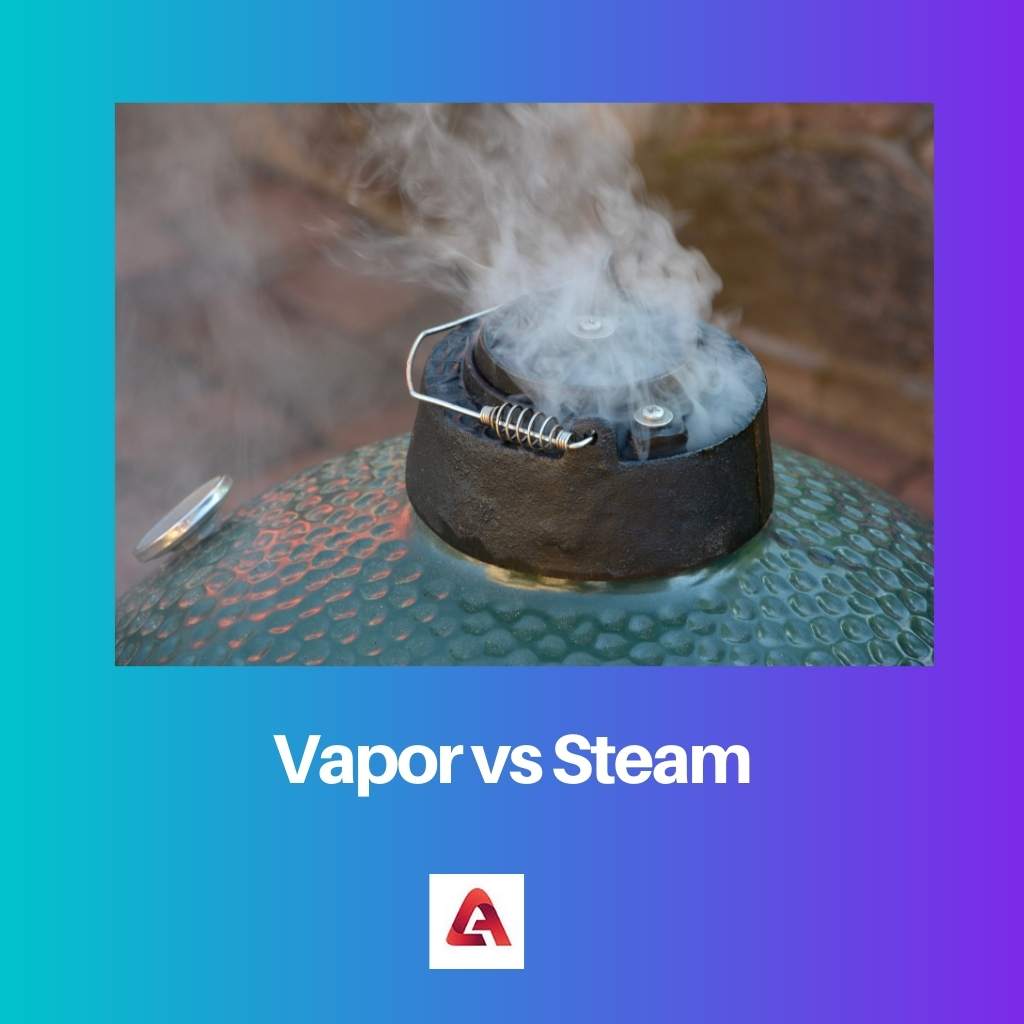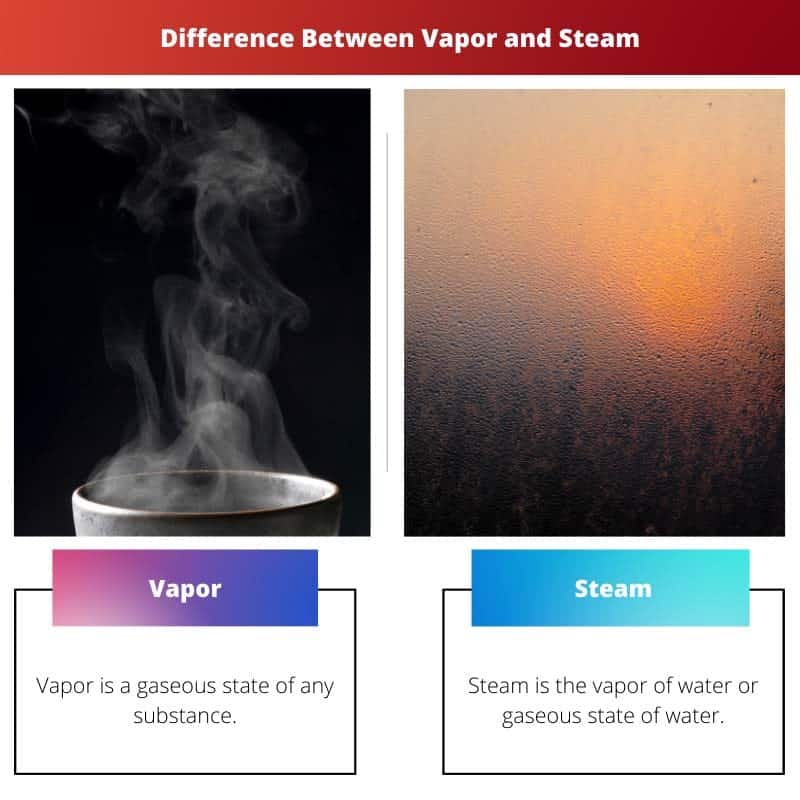In current times, these two terms have become very significant and widespread. Taking steam or water vapor has become a daily routine in most households.
Key Takeaways
- Vapor is a gas formed by the evaporation of a liquid or the sublimation of a solid, while steam is the gaseous form of water.
- Vapor can be any gas, while steam is the gaseous state of water.
- Vapor can be visible or invisible, while steam is always visible.
Vapor vs. Steam
Vapors are gaseous substances formed by the process of evaporation. Vapors can be converted into liquid if the pressure applied on them will increase while keeping the temperature constant. steam is the gaseous form of water which is formed when the water boiled above 100°C. It is invisible.

Vapor is a substance diffused in the air. The implications are liquid or solid at a certain pressure level. The gaseous vapor can be turned to liquid if the pressure is increased on it while keeping the temperature the same.
The gaseous state of water is called steam. At or above 100°C, water becomes steam. Boiling or evaporation can cause water to become steam. Steam is primarily invisible.
Comparison Table
| Parameters of Comparison | Vapor | Steam |
|---|---|---|
| Definition | Vapor is a gaseous state of any substance. | Steam is the vapor of water or a gaseous state of water. |
| Condition | The transition of any substance to become vapor depends on the volatility of the essence. | The transition of water into steam requires 100°C or more temperature. |
| Usage | Vapor is used to make perfumes, form mist, and generate light in mercury-vapor lamps. | Steam generates electricity, and it is also used in the sterilization of soil and heating of a building. |
| Effect on nature | Vapor does not have any beneficial contribution to wildlife. | Steam benefits nature, composes mist and makes soil healthy by sterilizing it. |
| Visibility | Vapor is visible and has a particular shape when put under the microscope. | Steam is invisible. We have moisture around us all the time. |
What is Vapor?
The gaseous state of any substance is called vapor. This substance is ordinarily solid or liquid at a specific pressure degree. A vapor consists of two different meanings at room temperature.
The gaseous vapor can be turned to liquid if the pressure is increased on it while keeping the temperature the same. Water steam is a kind of vapor, but all other types of smoke are not steam.
Vapor and aerosol are not the same things. Unlike vapor, aerosol possesses tiny particles of liquid, solid, or both within a gas. Vapor is entirely gas.
Most of the time, boiling a substance to form a vapor is unnecessary. Some volatile substances can turn into a gaseous state at standard temperature and pressure conditions.
Vapor gets used in the formulation of many things. Vapor is needed to compose perfume. Perfume contains vapor with tiny droplets. Vapor is also used to generate light in mercury-vapor lamps.

What is Steam?
Steam is water vapor. Water turns into vapor when water boils at 100°C or more temperature. This transformation of liquid into gas makes it able to be used as energy.
Steam is also beneficial to human health. Taking steam can decrease the chances of getting a cold or flu. Not only in humans’ health, but steam affects nature’s elements too.
Additionally, In cooking, steam is needed. Steamed vegetables are very beneficial to your body as they keep the vegetables’ nutritional values intact.
As acknowledged before, steam is the energy source; it produces electricity and can be used in ironing creased clothes. Steam energy also has heat to keep the buildings heated.

Main Differences Between Vapor and Steam
- Vapor is visible and has a shape that can not be seen with the naked eye, whereas steam is invisible.
- Steam generates energy, and vapor is mostly used to formulate perfume. Vapor is flammable. That is why it is advised to keep perfume away from flame and fire. Steam, on the other hand, is non-flammable.

- https://www.sciencedirect.com/science/article/pii/0375650573900229
- https://agupubs.onlinelibrary.wiley.com/doi/abs/10.1029/JB085iB11p06505
Last Updated : 11 June, 2023

Piyush Yadav has spent the past 25 years working as a physicist in the local community. He is a physicist passionate about making science more accessible to our readers. He holds a BSc in Natural Sciences and Post Graduate Diploma in Environmental Science. You can read more about him on his bio page.

This post adds a new perspective to the discussion of vapor and steam.
The section on what is steam? sheds light on the various applications of steam.
A well-detailed explanation of the differences between vapor and steam.
Agreed, the key takeaways section was a nice summary
The post stands as a vivid source of information regarding vapor and steam.
Indeed, the comprehensive explanation adds an enriching dimension to the topic.
The comparison table really simplifies the differences between vapor and steam.
The post provides an in-depth comparative analysis of vapor and steam, which is truly informative.
The detailed comparison table made it easy to understand the differences.
I agree, this is a great resource for understanding these concepts.
Vividly explains the nature of vapor and steam. A comprehensive and insightful read.
The comparison between vapor and steam usage is quite enlightening.
The distinction between vapor and steam is well-established with scientific references.
The detailed sources give credibility to the information presented.
The section on what is vapor? is particularly enlightening.
The informative content is a valuable addition to the existing understanding of vapor and steam.
I appreciate the thoroughness in the explanation of both vapor and steam.
The section on main differences between vapor and steam captures the essence of the comparison.
The scientific explanations have been presented in a clear and understandable manner.
Indeed, the post breaks down complex concepts in an easy-to-digest way.
A commendable effort to elucidate the characteristics and differences between vapor and steam.
Absolutely, the post is a valuable resource for understanding these concepts.